Since moving into Little Neck in 2007, I’ve been wedged between areas of varying ritziness, while maintaining my own hovel of relative poverty. If I wander west, I’m in the landmarked Douglaston peninsula, which was settled as early as the colonial area but whose homes mostly date to the 1920s. They’re Colonials, Federals and modern buildings mostly on voluminous lawns and accompanied by varying numbers of colorful and decorative vegetation, azaleas being prominent in mid-spring, as well as enjoyable water views. If I head east, I’m in Great Neck, whose downtown, Great Neck Plaza, is physically indistinguishable from Bayside except that its businesses are rather more expensive, with fur storage being quite prominent.
Still confined mostly to the immediate area and with my own cowardice about taking public transportation lest I contact any Covid 19 germs in spring 2020, I decided recently to embark on a walking voyage southeast, this time into an adjoining community called Lake Success.
GOOGLE MAP: LITTLE NECK AND LAKE SUCCESS
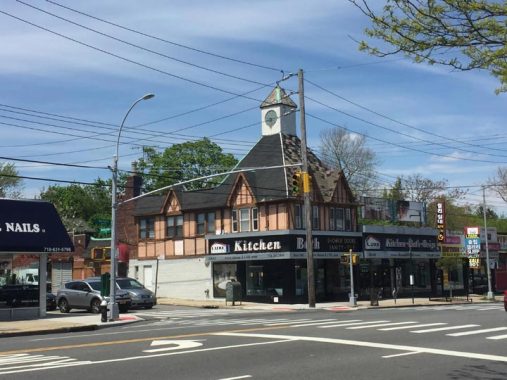
Since I moved to Little Neck this Tudor building with the clock tower at Northern Boulevard and Westmoreland Street has been an object of fascination for me. I cannot say why it was built with a clock tower, but I can show you a photo of it in 1940, when the clock worked, and it was above a cigar store that probably also sold newspapers and candy.
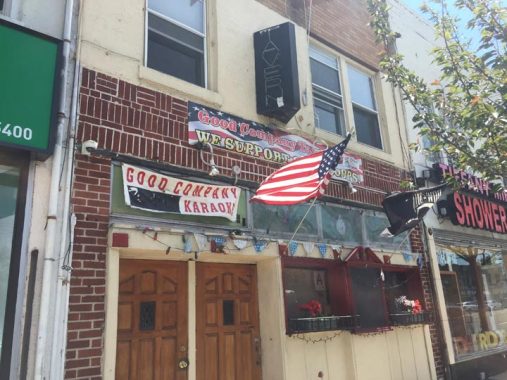
Bars, except for the ones in the fancier restaurants like Il Bacco, are in short supply in Little Neck. In fact two , Patrick’s Pub and the Little Neck Inn, have closed within my memory. This one, Good Company at 253-30 Northern, seems to be the Last Mohican. And it’s shuttered with the Virus Crisis.
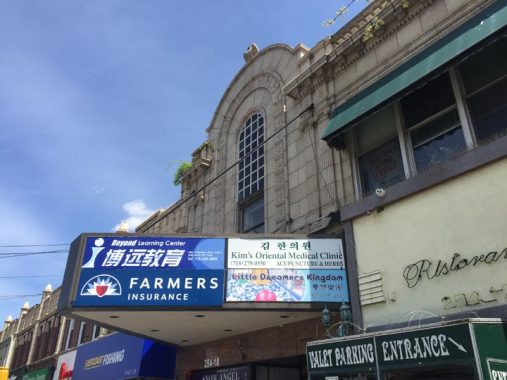
The closest movie theaters I know of are in Great Neck but this building, now home to a number of businesses including the La Grotta restaurant, used to be the Little Neck Theater, 254-18 Northern Blvd., opened January 7, 1929. The theater closed down in the 1980s after its air conditioning failed.

The border of Queens and Nassau Counties at Glenwood Street is surprisingly undefended whether by armed guards, canines or rollingpin-wielding housewives. To think that residents of Queens and Nassau can pass freely between the border is amazing! However, Queens and Nassau were once the same county, until 1898 when Queens’ western towns joined New York City and its eastern towns wanted no part of that, and decided to become their very own county, Nassau.
North of Northern Boulevard, the east side of Glenwood Street is actually in Nassau County for about a couple of football fields’ length. Thus you have addresses like 1 through 7 Glenwood, before Queens-style numbering resumes at 41-91. As we’ll see, though, there are spots well within Nassau that employ Queens numbering!
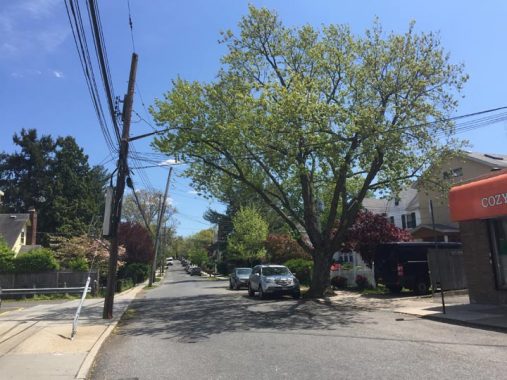
Glenwood Street ambles and meanders south for about a mile south of Northern Boulevard.
The city line protecting Queens from Nassau, and vice versa, runs just east of Glenwood and so, houses like these on the east side of the street are cut in two by the city line. I imagine, without talking to the buildings’ residents, that one or the other municipality, the City of New York or University Gardens in the Town of North Hempstead’s facilities and post offices service them.
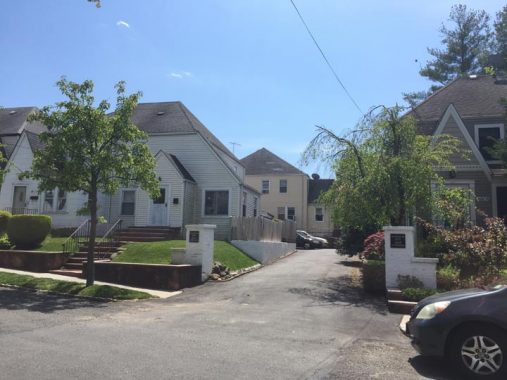
“Van Nostrand” was formerly a big name in Little Neck — the Little Neck Theater at Northern Boulevard and 254th Street, and the still-standing house in back of it on Pembroke Avenue, stand on land formerly belonging to 19th Century landowner William Van Nostrand, who also helped institute the Little Neck National Bank, which occupied a Moderne structure at Northern Blvd. and Little Neck Parkway that currently houses a branch of Chase.
Another reminder of Van Nostrand can be found in an L-shaped semiprivate alley, Van Nostrand Court, which runs from West End Drive to Glenwood Street south of Pembroke (yes, names tend to dominate instead of numbers near the Nassau County line). It’s one of those streets that show up on Google maps but not the print versions.
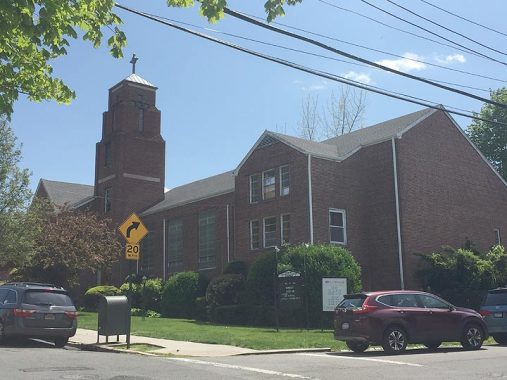
Christ Evangelical Lutheran Church, constructed in 1954, at West End Drive and Glenwood Street. This is actually the east end of Queens, but presumably the “West End” refers to the west end of Nassau County, which the east end of the street enters. Got it?
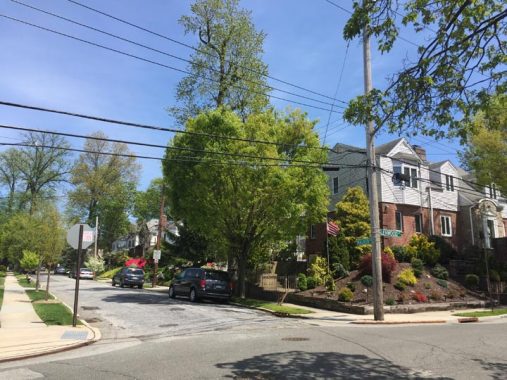
Walden Avenue ends at Glenwood Street in Queens, but most of it is in Nassau. Hence, the first two addresses are 254-08 and 254-12, but then you have 20, 24, 28 et cetera.
As Glenwood takes a bend to avoid a hill, it becomes a Tudor wonderland…
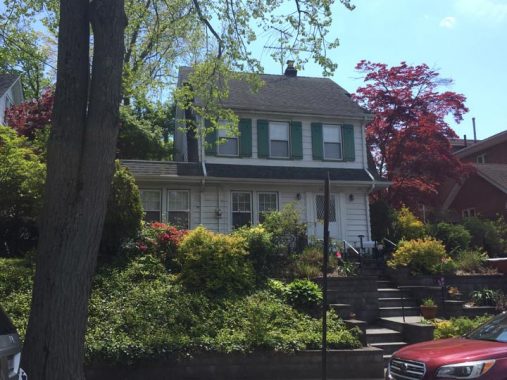
…as this tidy two story residence is attained up a flight of steps, with the hill supporting a large, colorful garden.
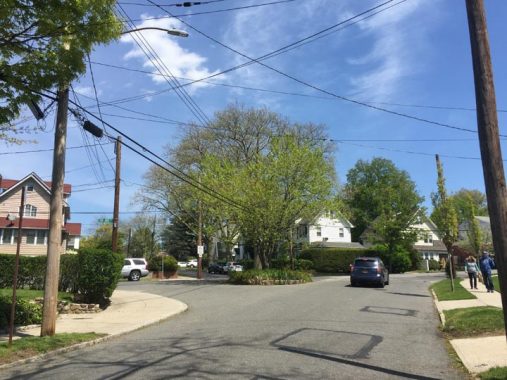
Glenwood Street ends at a small traffic circle at Concord Street, which, once it enters Nassau County becomes Concord Avenue and its house numbers lower into Nassau County range.
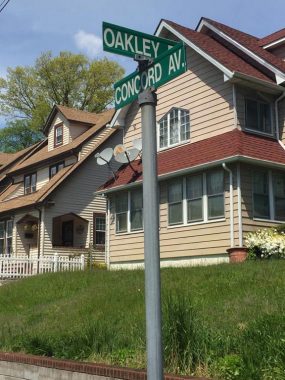
Standard issue street signs in Nasssau County featuring all caps Helvetica. These have slowly been giving way to newer signs using upper and lower case type; in the 2000s traffic engineers decided that those are more readable by drivers of moving vehicles.
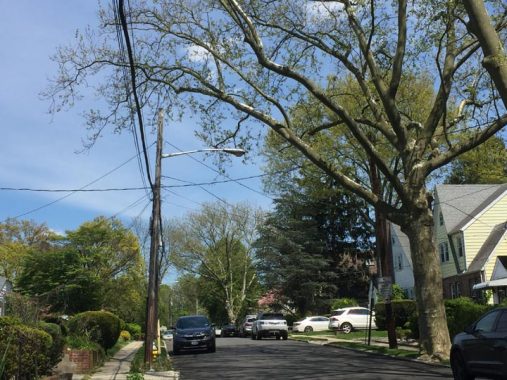
The agency that oversees street lighting in Nassau (I don’t know it, but it’s cognate to NYC’s Department of Transportation) is not quite as Naz… er, ah, stringent, in replacing older streetlamps with LEDs. For example, here’s a Westinghouse OV-15 mercury light on Oakley Place.
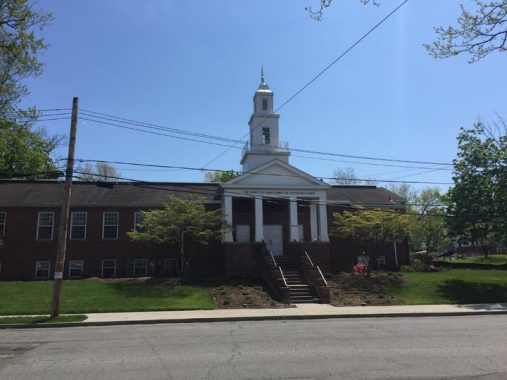
Here is the Queens Church of Jesus Christ of Latter-Day Saints, 254-10 Bates Road between Little Neck Parkway and Concord Street. Though the Mormon Church seems to be associated with the public imagination as centered in the western states, the faith was founded by Joseph Smith in western New York State. The faith breaks from other sects of Christianity in many ways, most importantly, it holds that God the Father and the Son are separate persons; for this reason, the Mormon Church is called non-Trinitarian.
The facility stands on the former site of the Little Neck School (1865-1914) which was supplanted by PS 94 on Little Neck Parkway and 42nd Avenue in 1914. The old school was home to the Powers Chemical Co. for several decades until the temple was constructed.
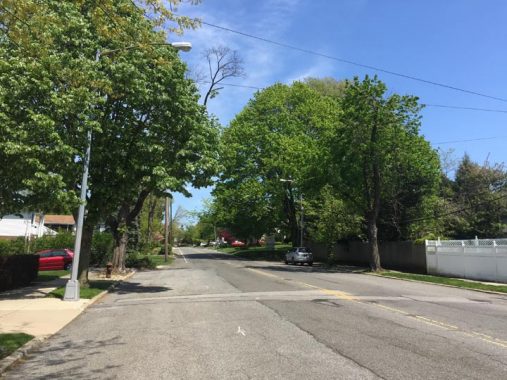
This is Bates Road at Concord Street, looking east. You can tell we’re right at the city line because in Nassau County, the road gets narrower, the shoulders and sidewalks disappear. In fairness, the sidewalk resumes on the north (left) side a few meters ahead.
Bates Road is shown as Lakeville Road on older maps from the early 20th Century. Undoubtedly the name was changed to avoid confusion with the longer north-south Lakeville Road that runs from Great Neck to New Hyde Park.
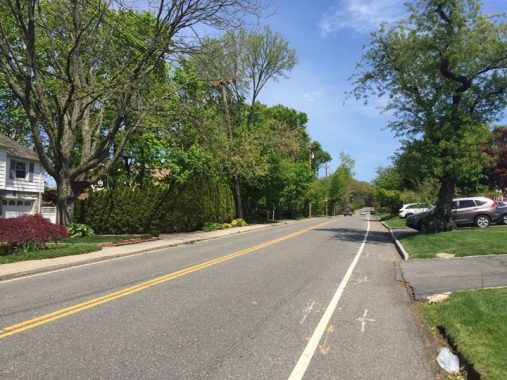
Once within Nassau, where it runs along the Lake Success-unaffiliated North Hempstead border, Bates Road is every inch the modern suburban highway.
There’s little standardization on signs marking counties and villages. The Nassau County sign was made with the Friz Quadrata typeface, which was notably used on the long-running Law & Order series of TV shows.
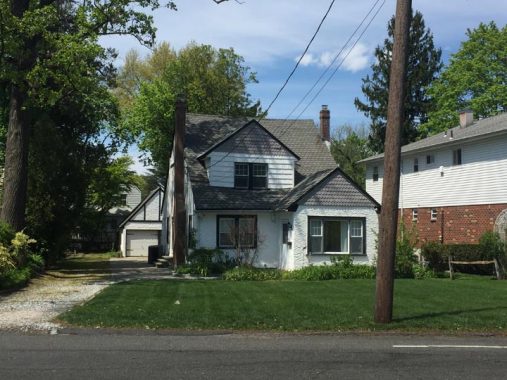
Because of the city line, #1 Bates Road is found midblock, just east of 254-41 Bates Road.
I’ll get into the appearance of the streets of Lake Success in a moment but here I’ll remark on the village’s street signs. Nassau County does not have a standardized street sign format and individual towns and villages can select their own designs and methods. In Lake Success, signboards are used that employ the Century Schoolbook Bold font, brownish shingles on white poles.
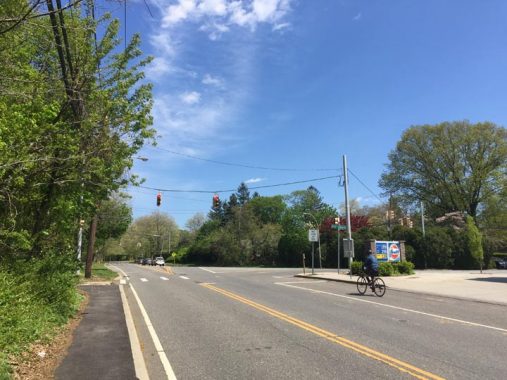
I decided to turn around where Horace Harding Boulevard assumes Bates Road’s route and continues east to meet the Long Island Expressway (which is called the Horace Harding Expressway in NYC, after a traffic engineer friend of Robert Moses’).
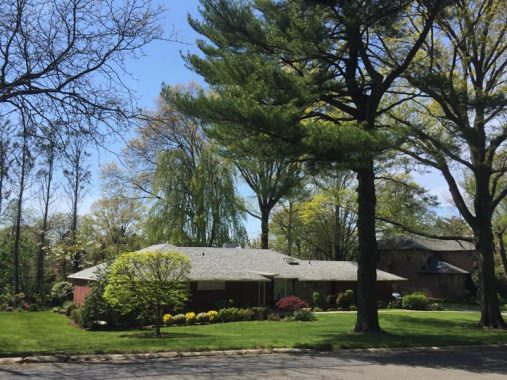
I have remarked that I find it fascinating that I can easily reach the village of Lake Success from Little Neck, and joked that its boundaries are unprotected. That’s because the village presents a distinct appearance contrasting with Little Neck or even nearby University Gardens, unaffiliated North Hempstead and Great Neck Plaza, as it is complete and utter suburbia down to its complete lack of sidewalks, street lighting, and its large plots are occupied by beautiful homes, half of which seem to be sprawling ranch houses. Ranch houses are my favorite type of domicile, not least because they lack staircases. When I worked in Port Washington at Publishers Clearing House, the office was a sprawling “ranch office” built on a former sandpit. The company has since relocated to Jericho in mid-Nassau.
Lake Success was incorporated in 1926, after the (quite successful) William K. Vanderbilt purchased land surrounding a large kettle pond originally named Sukut by Native Americans. The pond is now located within the Lake Success Park Golf Course off Lakeville Road. In 1939, the Sperry Gyroscope Company constructed a large facility in Lake Success that became the temporary HQ of the United Nations (first housed in the present Queens Museum in Flushing Meadows-Corona Park).
The median income in Lake Success is listed at about $135,000, which seems a bit low to me.
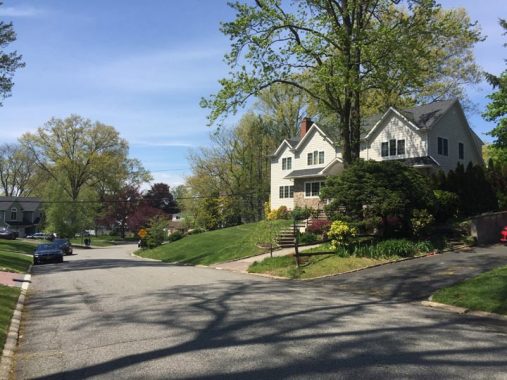
Looking west on Oaks Hunt Road, Lake Success.
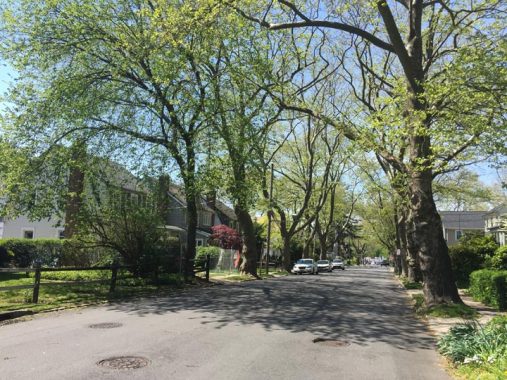
Looking north on Westminster Road at Kensington Place (yes, the streets frequently carry British-sounding names, as real estate developers really like the sound of them). Here, Lake Success is behind me and the unaffiliated portion of North Hempstead ahead, and the streets regain sidewalks and side trees.
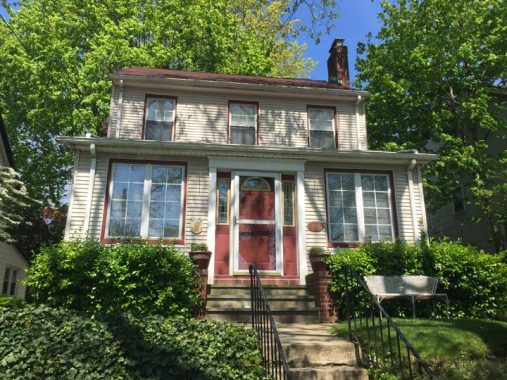
Here’s 4619 Westminster Road, which is numbered as if the next block north, Pembroke Avenue, was 46th Avenue. It used to be. Several University Gardens streets were given numbers in an extension of the NYC street numbered system. The streets were renamed a few decades ago, but the house numbers remain the same.
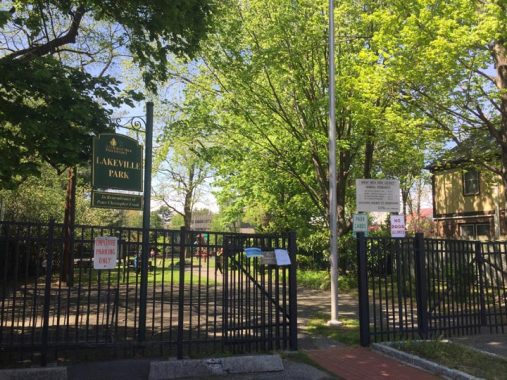
Great Neck’s Lakeville Park, at Pembroke Avenue and Concord Avenue (see above) remains open. NYC’s playgrounds have been closed because of the Covid crisis.
Check out the ForgottenBook, take a look at the gift shop, and as always, “comment…as you see fit.”
5/13/20


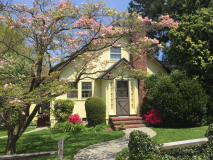
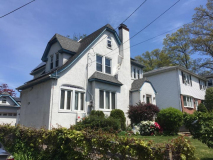
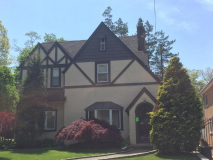
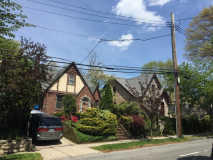


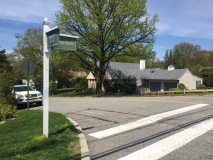
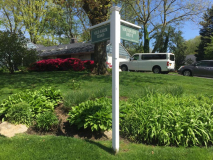
34 comments
Mormon churches and temples are not the same thing. Local congregations meet in ordinary churches, like the one in Little Neck, while the temples are big elaborate structures with generally no more than one covering metropolitan areas. Temples are off-limits to outsiders and even church members have to present proof of good standing in order to enter.
When I was in Idaho Falls in 2017 to watch the eclipse, it seemed rather amusing that the Mormon temple was looming over thousands of people smoking weed like it was some 1960’s rock concert.
I ran afoul of this before. Corrected.
Where I live in AZ, LDS churches & temples are as common & close together as Carvel stores were in Queens fifty years ago.
When I canvassed around that area for a politician I was surprised to learn that developers built over the city line like it wasn’t there. Residents paid proportional taxes to Nassau and NYC. People with kids chose lots over 50% in Nassau to get them in Nassau Schools. Other people chose NYC lots to avoid Nassau’s heavy property tax burden.
Interesting article. I like your detailed comments about signage. I grew up on Westminster Rd, inside the Village of Lake Success.
You should include something about Lakeville elementary School located in Lake Success.It’s an extraordinary example of a mid 20th century school. Great design and wonderful grounds
Lakeville was built in the 1920s. I went there 1959-65 when we had air raid drills and we learned of JFKs death. Sadly they added crappy annexes recently, taking away our basketball courts and kickball fields. Still, like you say,
the main school building is architectural perfection.
If Lake Success’s median income of $135,000 is per person rather than per household it’s not so low at all. Most of the housing stock consists of houses rather than apartments, and a good percentage of those houses contain families with (zero income) children. In addition, in well-to-do communities wives tend not to work.
Re: the former Little Neck Theater: Weight Watchers original home office was located on the second floor (click below)
https://www.mylifetime.com/she-did-that/may-15-1963-weight-watchers-was-founded-by-jean-nidetch
My mother attended the original Weight Watchers next to the Little Neck Theater in the 50’s.
The original meetings were in Deepdale not the offices over the theater
I humbly submit that the area around Westminster Rd and Kensington Place, near Lakeville Park, is not considered University Gardens. I grew up in Kensington, still live in the area, and have always believed that area with the Queens numbering, Pembroke Ave, etc., was part of the unincorporated area of Great Neck. The signage for University Gardens does not continue in that area… it stops around Hereford Road, which is what I thought was the westernmost boundary of University Gardens. Those houses in unincorporated areas will have much lower real estate taxes, as they don’t have the separate village taxes. FYI, there are nine incorporated villages in Great Neck, and there are also areas that are simply part of the Town of North Hempstead. Some of that area east of Little Neck Parkway is, in fact, unincorporated. https://www.maps-streetview.com/United-States/University-Gardens/streets.php
Fur storage is quite prominent in Great Neck Plaza? Maybe in the 1960s… you’d be hard pressed to find even one fur storage company in Great Neck Plaza now. There are quite a few empty storefronts, and the majority of businesses are restaurants and banks… plus, of course, the ubiquitous CVS. The era of the high-end clothing boutique in Great Neck is long gone.
This article really doesn’t have much to do with Lake Success, it’s “a quick trip to the Little Neck border of Lake Success”.
Thank you for the clarification.
Does anyone here remember Lakeville Stables. It was on the same property as Lakeville Manor, the north side of the L.I.E. between Community Dr. and Lakeville Rd? My uncle from Bayside kept his horse boarded there in the
Sixties and Seventies. Run by a family named Gormley.
My sister took riding lessons there in the late fifties.
I met my first wife there, she was a real nag. Thanks, I’m here all week.
I took riding lessons there In the late 50s…
Kevin, Andy Sparberg here. Just want to paraphrase and expand my comments from a similar FNY essay about this area from about two years ago. It was correctly noted that Westminster Road “is numbered as if the next block north, Pembroke Avenue, was 46th Avenue. It used to be. Several University Gardens streets were given numbers in an extension of the NYC street numbered system. The streets were renamed a few decades ago, but the house numbers remain the same.”
Allow me to expand upon why Pembroke Avenue and a few of its adjoining streets keep their Queens numbering in Nassau County. I’m quite familiar with the territory, as I lived in Great Neck for about twenty years in my younger days (until 1970) but continued to be a regular visitor to the area until around 2012.
There are seven short N-S streets between Northern Boulevard and Pembroke Avenue, beginning with Buttonwood Road and continuing east to Arcadia Lane. Until the mid-1960s each of these was numbered, beginning with 256th Street (Buttonwood) proceeding east to 262nd Street (Arcadia), an obvious continuation of Queens street nomenclature for a few blocks.
The Town of North Hempstead, which is the local government body for this portion of Great Neck, decided to eliminate the numbered streets in the mid-1960s and adapt the names used today. All were new except for Jayson Avenue (260th), which was already the street name north of Northern Boulevard. The Queens-style house numbers were not changed and persist to this day, encompassing a few more blocks than shown on the map. Jayson Avenue terminates at the Lakeville Elementary School, 47-27 Jayson Avenue, but was originally 47-27 260th Street.
Use this link to access a 1946 Hagstrom map of this area: http://www.historicmapworks.com/Map/US/1598550/Nassau+County+Plate+005/Queens+and+Nassau+Counties+1946+Long+Island/New+York/
The map clearly shows the numbered streets noted above. The map can be enlarged enough to read the print.
Today’s essay also pinpointed one of the reasons for high property taxes in Nassau – the marble cake of overlapping government jurisdictions. Your path took you from an unincorporated area (Town of North Hempstead) into the incorporated village of Lake Success. The biggest consumers of taxpayer dollars, the school districts, typically overlay a combination of villages and unincorporated areas (towns). The Great Neck school district, which stretches from the tip of Kings Point to Hillside Avenue, is such an example. It encompasses nine incorporated villages and a multitude of North Hempstead Town unincorporated neighborhoods. The police forces are similarly balkanized – four villages in the Great Neck area have their own forces, while the remaining villages and unincorporated area are part of the Nassau Police Department 6th Precinct. Lake Success is one of the four that has its own police force.
I grew up in University Gardens from 1952 to 1968 and thought I knew the area. I walked and rode my bike everywhere and drove a laundry truck for Kassan and delivered commercial printing for MR . Slattery who published the Great Neck Record, but the city line area that you describe is confusing to me, unrecognizable.
Nina Gordon was right to correct you. The city line streets that you mentioned, Glenwood, Walden, Concord, Bates, Westminster, Horace Harding are all in unincorporated North Hempstead and some of them in the Uplands neighborhood or Lake Success Hills. Not the Village of University Gardens which is on the other side of Lakeville School, around Steve Sloane’s childhood home. I lived in Upland Road and delivered Newsday all around those neighborhoods.
I grew up in Lake Success Hills, the unincorporated step sister of Lake Success bordered by Horace Harding Buoulevard, the LIE, the Queens line and Lake Success. We could walk to get pizza and bagels in Little Neck, and walk to Cal’s on a Horace Harding for Candy, and sandwich counter and True Confessions magazines.
Omg. Cal’s hadn’t thought of that place In decades. Went there sometimes after school ( lakeville)
We spent 6 months living in Little Neck in 1968 when we relocated from the England. My father had been recruited by a company in the U.S. and he worked in Manhattan. We lived in Wilwade and attended the Lake Sucess(?) school for a few months before the summer vacation. It was an experience I will never forget as an 8 year old. I remember we’d go across to Cal and Ethel’s(?) for candy. We spent the summer at the local country club, can’t remember the name and did two road trips to Virginia and other states. I remember a couple of friends we made, Jeffrey Solomon and another lad called Sandy. Happy memories!
Street lights in Nassau County are maintained by the village or town.
I was born and raised at 254-22 Iowa Road (& Concord ave) in the early 50’s. The city line split our property, so Dad had to pay Nassau taxes on our house and NYC tax on our garage. I went to Lakeville, was friends with Eddie and Tommy Ford so spent lots of time at Whitey Ford’s house in Lake Success. Every weekend there were many NY Yankees there hanging out – Mickey Mantle, Roger Maris, Yogi, a dozen hall of fame players. The Ford house was a refuge for them. Whitey passed away today, but I’ll never forget those times and seeing Whitey at every little league and Great Neck South team games. Thanks for rekindling fond memories.
Wow this brings back memories. Learned to ride a bike on bates road. Lived on market lane just off Bates. Went to
Lakeville school in the 50s. Walked to school. Remember buying candy at Cals. Swimming at the pool. Playing ball on
Oaks hunt road. The good humor man coming thru the neighborhood. Simple times. Nice memories. Lived there from 1950-62.
Wow. You seem to have hit every footstep of my childhood!
I remember Cal and Ethels. Egg creams and french fries after school. Ethel wore what looked like to me Cal’s old worn out shoes. There was also the Associated super market. Tricatella’s service station. Simpler times.
Trincatella’s….sorry typo
Thank for the memories! I grew up on Vanderbilt Drive (off Horace Harding Blvd.) in Lake Success in the ’60s’-70s, and went to Great Neck South. Spent lots of time in Little Neck/Douglaston area. Anyone recall Kiddy City amusement park? Awesome place. Got my haircuts at the Douglaston plaza that had Centre Pizza and Carvel Ice Cream. Both parents’ wakes were held at Shaffer’s Funeral Home on Northern Blvd. Had many great meals (and pints) at Patrick’s Pub (really sad that it closed).
You were class of 71, #52 on football team. We know the same 200 people.
Hey Bobby! Actually, I was class of ’73…but you nailed my football jersey number. Thanks for commenting.